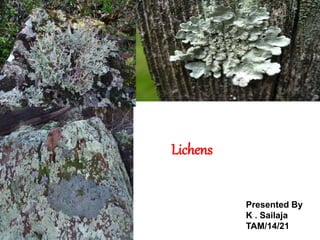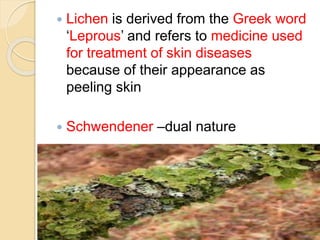Lichens ppt
- 1. Presented By K . Sailaja TAM/14/21 Lichens
- 2.  Lichen is derived from the Greek word ‘Leprous’ and refers to medicine used for treatment of skin diseases because of their appearance as peeling skin  Schwendener –dual nature
- 5. Relationship between algae and fungus - Mutualism - both gain benefits -Algae produce carbohydrates as food supply -Fungus with hyphae holds the structure firmly on substrates and absorb mineral salts -Controlled parasitism
- 6. Photobiont  Green algae – Trebouxia is a common genus, found in 75% of lichens in temperate zone  Cyanobacteria – Nostoc is a common genus  25 genera of algae and 15 of cyanobacteria found in lichens, 90% of lichens contain Trebouxia, & 8 % Nostoc or one other genus
- 7. Mycobiont  Most lichenized fungi are Ascomycotina – most form apothecia, some form perithecia and pseudothecia.  12 orders include mostly lichenized members (Arthoniomycetes , Eurotiomycetes , Leucanomycetes , Lichenomycetes )  Some are Basidiomycotina – Aphyllophorales, few Agaricales .  Some are Deuteromycota  20% of all fungi & 40% of ascomycotina are lichenised( Krik et al.,2008).
- 8. In culture what happens ? Photobiont : ÔÇó Trebouxia : produces zoospores produce gelatinous sheath ÔÇó Nostoc : produce gelatinous sheath Mycobiont : ÔÇó Develops into an undifferentiated mass
- 9. Optional lichenization  As ecological adaptation (sedin et al ., 2004 )  Conotrema (lichenizing fungi )  Strictis ( non –lichenizing )  Both belongs Leucanoromycetes (Pezizomycotina ).
- 10. Thallus morphology  4 basic types  Crustose – flattened, scalelike,  No lower surface, tightly bound to substratum
- 11. Thallus morphology  Fruticose – branched, strap shaped or threadlike thallus, upright or hanging
- 12. Thallus morphology  Foliose – flattened branching lobes loosely attached to the substratum, leaflike  Have upper and lower surfaces  Anatomically similar to angiosperm leaf.
- 13. Thallus morphology  Squamulose – intermediate between foliose and crustose  Scales, lobes smaller than in foliose
- 14. Growth  Exhibit low growth rates (crustose) – many grow at rates of 1-4 mm/yr, up to 9 cm/yr (foliose)  Makes studies difficult Factors affecting growth  Light – variable – some prefer low light intensities, others high  Temperature – variable  Moisture – appears to be an important variable, do not have water absorbing organs, depend on moisture in air
- 15. Moisture  When lichen thallus is wetted, absorbs water quickly by gelatinous matrix in the cortex Starts growth process  As thallus dries, growth process slows and stops  Dew and humidity are important sources of moisture  Thalli are inactive when dry – only grow when wetted  Most of them require low light intensity, cool temperature & moisture.  may be responsible for slow growth rate
- 16. Asexual reproduction ÔÇó Fragmentation ÔÇó Soredia - algal cells enveloped by hyphae, no cortex, form powdery masses on surface of thallus, detach from thallus
- 18. Isidia – column like structures with cortex
- 20. Sexual reproduction ÔÇó characteristic of fungal symbiont ÔÇó Ascospores are discharged, algal cells are not discharged with them ÔÇó Thought that after ascospores germinate, they make contact with algal cells
- 24. Lichen acids  The metabolites (mainly secondary) are antimycobacterial, antiproliferative, antiviral, antibiotic, anti-inflammatory, cytotoxic, analgesic and antipyretic effects.  belongs to depsides & depsidones (which are condensation products of 2-or 3 phenyl carboxilic acids mainly orsellinic or ß- orsellinic acid held together by ester linkage
- 25. Role of lichen acids  Usnic acid – wide spectrum antibiotic activity (Shibamoto and Wei, 1984, Rowe et al., 1991).  Vulpinic acid exhibited mild antibiotic activity (Lauterwein et al.,1995).  These acids inhibited the growth of Bacillus subtilis, Staphylococcus aureus and Bacillus magaterium.
- 26. Lichen acids ÔÇó As defense chemicals against attacks by slugs & other minute animals ÔÇó Have good chelating properties (metal binding ) ÔÇó Tranlocate substances between partners ÔÇó Increase permiability of algal cells ÔÇó Stabilize the amount of light reaching the photobiont layer
- 27. uses
- 28. As source of food ÔÇó Cetraria islandica was used as food in Northern Europe and was cooked as porridge, soup, bread, salad and pudding. ÔÇó Bryoria fremoontii were mostly used as food in times of famine in North America so they were called famine food. ÔÇó In China, lichens are used as food (Lobaria isidiophra, L.yoshimurae) and also as health promoting tea (Thamnolia subuliformis, Lethariella cashmeriana).
- 29. As fodder ÔÇó Cladonia rangiferina in taundra, ÔÇó Cetraria islandica in iceland ÔÇó Sps of Lecanora ÔÇó Nutritive value is due to lichenin As initiators of vegetation on rocks Crustose lichens are primary colonizers
- 30. ÔÇó Some lichens known as Earth Flowers have a strong and distinct odour so they are smoked along with tobacco used in summer dances (Curtin, LSM. 1984). Medicinal properties ÔÇó Peltigera canina - hydrophobia ÔÇó Parmelia saxatilis - epilepsy ÔÇó Lobaria pulmonaria - lung infections
- 31. Perfumes & dyes  The extracts are used to dye wool .  They are also used in the manufacture of ‘moss’ and ‘leather’ & fragrances in perfumes and some type of soaps (Richardson, D. H. S. 1974)
- 32. lichenometry ÔÇó 1st employed by Faegri 1950 ÔÇó Most accurate when rocks are lessthan 1000 yrs ÔÇó 10,000 yrs maximum age limit (10 % error ) ÔÇó Mostly used are ascomycetous genera Rhizocarpon & Xanthoria elegans
- 33. Lichens are advantage over vascular plants As a bioindicator of air pollution: because they have no wax & cuticle to protect cells (inner structure) Cortex: Fungal layer Algal layer Medulla
- 35. Fruticose : The most sensitive Lichens are differently sensitivity to air pollution
- 37. Crustose :The most resistance
- 38. Lichen are efficient indicator of air pollution & acid deposition. They are less cost comparing with expensive equipments. Appropriate technique should be developed especially in developing countries to use lichens as bio-monitoring of air Pollution. Lichens provide warning signal before severe damages occur on ecosystem & health.
- 50. Thank you

















































